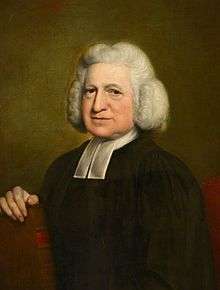Soldiers of Christ, Arise
"Soldiers of Christ, Arise" is an 18th-century English hymn. The words were written by Charles Wesley (1707–1788),[1] and the first line ("Soldiers of Christ, arise, and put your armour on") refers to the armour of God in Ephesians 6:10–18.[2][3]
| Soldiers of Christ, Arise | |
|---|---|
 Charles Wesley | |
| Genre | Hymn |
| Written | 1749 |
| Text | Charles Wesley |
| Based on | Ephesians 6:10-18 |
| Meter | 6.6.8.6 |
| Melody | "Diademata" by George Job Elvey |
History
Wesley initially wrote the hymn as a poem titled "The Whole Armour of God, Ephesians VI" in 1747 and was used to defend against criticism of Methodism in the United Kingdom.[4][5] During their evangelical careers, both Charles Wesley and his brother John Wesley received physical abuse because of them. As a result, this hymn was written and also became known as "The Christian's bugle blast" because of the military references and the apparent call to arms when it was set to music.[6] The hymn was published as "Soldiers of Christ, Arise" in 1749 in "Hymns and Sacred Poems" with 16 verses of 8 lines.[4] In 1780, it was published as a hymn in John Wesley's "A Collection of Hymns for the Use of the People Called Methodists" with 12 verses. Since 1847, the hymn is usually only performed with 3 verses.[4]
In the hymn, the words "adamant and gold" are used. This is speculated to be Wesley making reference to John Milton's poem, Paradise Lost where it says "Satan, with vast and haughty strides advanced, Came towering, armed in adamant and gold." This suggests that Wesley intended for the hymn to be for Christians to use Satan's ways against him.[1]
Wesley wrote a unique piece of music entitled "Soldiers of Christ" for the hymn to be set to.[1] However the hymn has been set to other tunes as well. One of several tunes for the hymn is by William P. Merrill (1867–1954) however, the main alternative piece of music that is used for the hymn is "Diademata" by George Job Elvey. It is opined that this music has become more associated with "Soldiers of Christ, Arise" than the original "Soldiers of Christ" music.[7]
Usage
The hymn is played using Diademata after first being published in the Anglican hymnal, Hymns Ancient and Modern,[8] It is also played with Diademata in the Seventh-day Adventist Church hymnal[9] and the hymn appeared in the Manchester Hymnal. In the United Methodist Church hymnal, "Soldiers of Christ, Arise" is the only hymn in it that was originally in John Wesley's A Collection of Hymns for the Use of the People Called Methodists.[5] It is one of only a few Methodist hymns that overtly referred to battles or the notion of Christians as soldiers.[5]
References
- The Cyber Hymnal: Soldiers of Christ, Arise. Retrieved 2014-01-14.
- Ephesians 6:10–18, NIV (BibleGateway).
- Wolffe, John (1994). God and Greater Britain: Religion and national life in Britain and Ireland, 1843–1945, Routledge, ISBN 0-415-03570-8, p. 227.
- "Soldiers of Christ, Arise". The Center For Church Music. Retrieved 2014-01-07.
- Williams, Jeffrey (2010). Religion and Violence in Early American Methodism: Taking the Kingdom by Force. Indiana University Press. p. 2. ISBN 0253004233.
- Osbeck, Kenneth W. (2002). Amazing Grace: 366 Inspiring Hymn Stories for Daily Devotions (2 ed.). Kregel Publications. p. 305. ISBN 0825493528.
- "Soldiers of Christ, arise". Hymnary.org. Retrieved 2014-01-07.
- Osbeck, Kenneth W. (1985). 101 More Hymn Stories, Part 2. Kregel Publications. p. 67. ISBN 0825493285.
- "The Church Hymnal ... Seventh-Day Adventist Church 366. Soldiers of Christ, arise". Hymnary.org. Retrieved 2014-01-07.
External links

- Soldiers of Christ, Arise (mp3 with organ only)